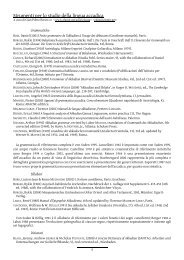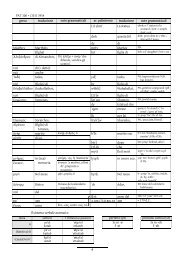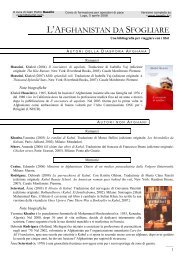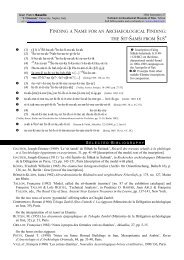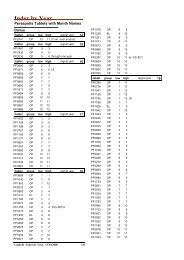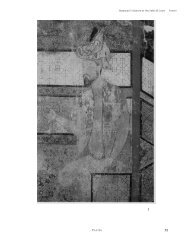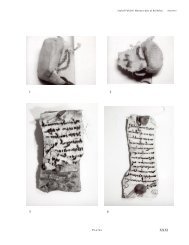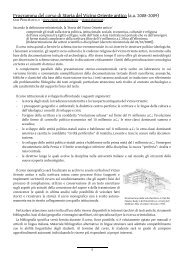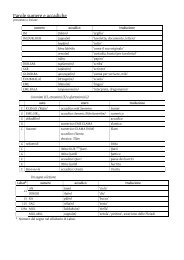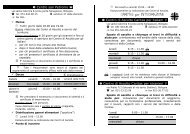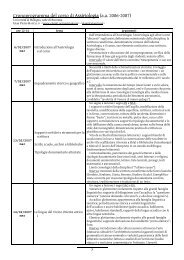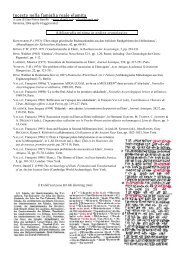Cyrus and his Cylinder: The King and his Mirror - Elam.net
Cyrus and his Cylinder: The King and his Mirror - Elam.net
Cyrus and his Cylinder: The King and his Mirror - Elam.net
You also want an ePaper? Increase the reach of your titles
YUMPU automatically turns print PDFs into web optimized ePapers that Google loves.
BASELLO & GIOVINAZZO, <strong>Cyrus</strong> <strong>and</strong> <strong>his</strong> cylinder<br />
he took the name from the Achaemenid king, eight centuries after the son of <strong>Cyrus</strong> conquered<br />
Egypt. Even today, the name <strong>Cyrus</strong> (Ciro in Italian) is widely attested among Neapolitan people.)<br />
Coming back to the Bible, the passages related to <strong>Cyrus</strong> are especially focused on the royal<br />
chancellery <strong>and</strong> its communication practice. In the Bible book of Ezra 1:1 it is stated that <strong>Cyrus</strong>, in<br />
order to communicate <strong>his</strong> royal will, ‘had (causative verbal form) the (i.e. <strong>his</strong>) voice (qol) spread<br />
<strong>and</strong> also (gam) in (be) writing (miktab)’, i.e. with an edict. <strong>The</strong>n follow, in a somewhat pleonastic<br />
way, the usual introductory formula ‘Thus <strong>Cyrus</strong> said’. T<strong>his</strong> form is widely attested in the books of<br />
the Bible; it is well-known also from the Achaemenid inscriptions, since Darius the Great on (θāti<br />
dārayavauš xšāyaθya).<br />
In the book of Ezra 1:8, we read that ‘<strong>Cyrus</strong>, the king of Persia, had some vessels (keli, a<br />
generic term) brought out (yaṣa’) <strong>and</strong> counted (safar) by the treasurer (gezbar) in front of (le) the<br />
prince of Judah’. <strong>The</strong> word for treasurer, gezbar, elsewhere gizzavar, is a loanword from Old<br />
Persian *ganza-bara-; the name of the treasurer, Mithredat, is clearly Iranian (*miθradāta-), too.<br />
<strong>The</strong> vessels were, precisely, ‘at (‘al) the h<strong>and</strong> (yad) of the treasurer’. T<strong>his</strong> expression is a reminder<br />
of Aramaic lyd, attested on the Aramaic texts on stone vessels from Takht-e Jamshid, in turn a<br />
calque of Akkadian ša qat <strong>and</strong>, perhaps, of <strong>Elam</strong>ite kurman (if kurman in the administrative<br />
documents from Takht-e Jamshid is connected to the word kurpi ‘h<strong>and</strong>s’ in the Bisotun inscription).<br />
<strong>The</strong> translation given above is a literal one: obviously, the meaning has to be transposed, so ‘at the<br />
h<strong>and</strong>’ means ‘under the responsibility of’, ‘to bring out’ means ‘to release’, <strong>and</strong> ‘to count in front<br />
of’ means ‘to attest’ or the like.<br />
More words should be spent on the asserted oneness of the <strong>Cylinder</strong>. First of all, it is certainly<br />
not unique for its shape <strong>and</strong> material: clay cylinders are attested in several instances from<br />
Mesopotamia.<br />
(Ellis, Foundation Deposits in Ancient Mesopotamia, fig. 36)<br />
Going back in time, two cylinders of Gudea, the Sumerian sovereign of the 22nd century BC,<br />
are known. A four-sided prism (i.e. a parallelepiped of clay, similar to a st<strong>and</strong>ing quadrangular<br />
stone), ca. 30 cm high, provides a chronological list of the Larsa dynasty (20th-18th century BC).<br />
3




